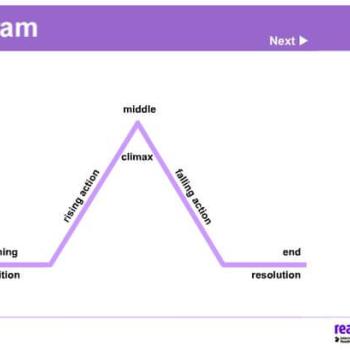

The Plot Diagram is an organizational tool focusing on a pyramid or triangular shape, which is used to map the events in a story. This mapping of plot structure allows readers and writers to visualize the key features of stories.
The basic triangle-shaped plot structure, representing the beginning, middle, and end of a story, was described by Aristotle. Gustav Freytag modified Aristotle's system by adding a rising action and a falling action to the structure. This interactive version of the graphic organizer supports both Aristotle's and Freytag's conceptualizations of plot structures.
Lights, camera, action, and a bit of mystery! In this lesson, students use mystery props in a skit bag to create and perform in short, impromptu skits.
Lesson PlanIn this lesson students evaluate published children's picture storybooks. Students then plan, write, illustrate, and publish their own children's picture books.
Lesson PlanPicture books provide the basis for an analysis of fairy tale elements before students write their own original tales.
Lesson Plan Standard LessonStudents read picture books to explore the concepts of plot development and conflict resolution. They first learn about the connections between reading and writing, and then revise their own writing.
Lesson Plan Standard LessonFrom "once upon a time" to "happily ever after," students learn to recognize story structure in fairy tales and create a logical sequence of events when writing original stories.
Lesson Plan Standard LessonStudents read and analyze fairy tales from several cultures, identifying common elements. Choosing common situations, students write original fairy tales, using picture books as models and a peer review process.
Lesson Plan Standard LessonBy exploring the decisions points in a tragedy, students consider how the plot of the story can change if the key characters make a different choice at the turning point.
Lesson Plan Standard LessonStudents use an online graphic organizer to analyze the plot structure of "Jack and the Beanstalk" and three short stories.
Lesson Plan Standard LessonThis lesson pairs the reading of historical fiction with nonfiction to introduce students to the large themes of history.
Lesson PlanExplore reading strategies using Edgar Allan Poe's "The Raven" and other works. Students read Poe's works in both large- and small-group readings then conclude with a variety of projects.
Lesson PlanDr. Seuss's The Cat in the Hat is used as a primer to teach students how to analyze a literary work using plot, theme, characterization, and psychoanalytical criticism.
Lesson PlanThe movie Shrek introduces the satirical techniques of exaggeration, incongruity, reversal, and parody. Students brainstorm fairy tale characteristics, identify satirical techniques, then create their own satirical versions of fairy tales.
Lesson Plan Standard LessonStudents apply the analytical skills that they use when reading literature to an exploration of the underlying meaning and symbolism in Hieronymous Bosch's early Renaissance painting Death and the Miser.
Lesson Plan Standard LessonIn this graphical mapping project, students assign a value to the events, characters, and themes in a novel and think about how the elements of the story are all interconnected.
Lesson PlanAfter exploring Orson Welles' 1938 broadcast of H. G. Wells' War of the Worlds, students create their own audio dramatization of a text they have read.
Lesson Plan Standard LessonStudents learn that the plot structure described by Freytag's Pyramid is actually quite familiar as they diagram the plots of a familiar story, a television show, and a narrative poem.
Lesson Plan Standard LessonStudents explore familiar literary characters, usually first encountered as adults, but whose childhood stories are only told later. Students then create childhoods for adult characters from books of their choice.
Lesson Plan Standard LessonStudents read an example of allegory, review literary concepts, complete literary elements maps and plot diagrams, create a pictorial allegory, and write diamante poems related to the theme of change.